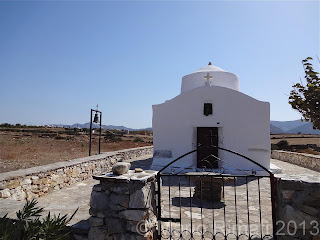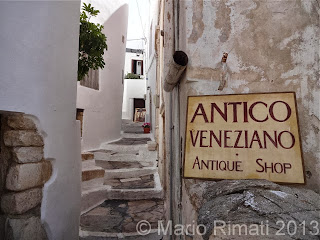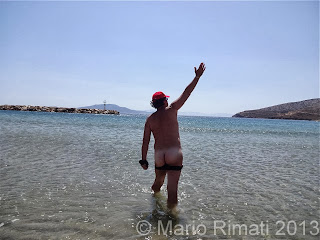(Here below the "Gate" at Hora)
The island’s airport is rather small, which is a pity because tourism-wise it could have even more visitors. The flights aren’t that frequent so we had to fly from Rome to the island of Mykonos, also known as the “gay capital of the Aegean Sea” (no point in hiding the fact, but someone like Freddie Mercury would have no doubt been very, very happy there)! From there we took a short bus ride to the town’s port and then the ferry, about 90 minutes, to Naxos. From the port we took a taxi to our studio (about 8 kms away, but the area has all the services necessary such as mini-markets and LOTS of tavernas with some fine Greek cooking).
(Ahh, those wonderful coffee frappés!)
Naxos is the largest and most important island of the Cyclades, a rich land with a natural environment suitable for the development of farming and stock-raising. The island has been inhabited for the last 6,000 years. We saw some ancient temples that date back as far as 800 B.C. One in particular is very dear to many wine aficionados out there, the one dedicated to Dionysus, the god of wine (soooo dear also to my old father)! He was born there. Apparently, Zeus also lived on the island.
(Just some of the small and adorable churches in the small towns)
(Very ancient temples!)
The island itself has “only” 500 churches (some as big as one’s bedroom actually, but very charming) and with some 60 kms of coastline. The one in the town’s capital Hora, is very beautiful.
The Italians: yes, there had been an Italian presence even on Naxos which went back to 1207 and the Venetian Marco Sanudo. He landed there and built his own castle, the Kastro (old walled city), on the island’s capital, Hora (you can still visit the castle).
The most recognizable landmark of Naxos is the Portara, an iconic 6th century BC marble gate on the islet of Palatia in Naxos harbor. It is the only remnant of a temple dedicated to Apollo. Naxos is well known for its wonderful beaches, some with advantageous winds for prime windsurfing and kite-surfing. Most of the island's West coast is one long sandy beach with crystal clear azure water, the most popular areas of which are Prokopios, Agia Anna, Plaka and Mikri Vigla. It also has a mountainous interior with a great variety of valleys and villages, easily reachable by a well-maintained road system. Archaeological highlights include the Kouros of Melanes and Apollonas, Dimitra's Temple at Sangri and the Cheimarros Tower.

The Kastro section, on its elevated ground overlooking the harbor, provides some of the quietest and most photogenic alleyways to be found in the town. It survives from the days when Naxos was an outpost of the Venetian empire.
Truly ancient ruins are limited to the Portara gateway, visible from the harbor, and a rather modest half-finished Kouros statue uncovered in a quarry near Melanes (Kouronohori) as well as a larger version near Apollonas on the northern coast. Special attention has been given in recent years to the sites of Dimitra's temple at Sangri, and Dionysus's temple below Glinado village, where the Ministry of Culture organizes full moon concerts in July and August.
Greek specialties like moussaka, souvlaki and a wonderfully mild feta are available in restaurants. The olive oils one encounters are superior to the 'light virgin' oil commonly available, in that the local process apparently leaves in much more olive flavor.
(The beach at Paros!)
(Yes, they do say that I'm NOT a normal person!)
There are also supermarkets on the outskirts of Hora which offer food and drink at everyday prices. Greece is also the only place where I get to enjoy my coffee frappés! As many rooms come complete with cooking facilities, this offers an excellent way to keep expenses down.
(Our quaint little studio in Naxo, just 100 meters from the beach!)
Naxos is famous for producing its own liquor called kitron, made from an exotic fruit which can be compared perhaps to lemons, though kitron's taste is pleasantly sweet and citric. Its production process can be viewed at the old Valindras distillery in the village of Halki, where different varieties can also be tasted. Kitron is also produced by Promponas.
(The center of Naxos)
(The spacewoman of Naxos!)
(The ancient temple of Dionysos)
And the islanders? In 6 trips so far to Greece I STILL have to find one single Greek who has been rude or inefficient. At least 99% of the people, with the exception of a few local shepherds, also speak rather good English (the same CAN’T be said of the average Italian). But this is also thanks to their tv programs, many which are subtitled and NOT dubbed (as in Italy’s case).
(The beautiful main church in Naxos)
(A rough life indeed sipping on a coffee frappe'!)
(It's a rough life in Greece, but somebody's gotta do it!)
Very, very wonderful people and above-all, VERY laid-back too: we had our beach about 100 yards from our studio (which we highly recommend, it can be viewed at: www.actiplaka.gr). For the last 3 trips to Greece we’ve chosen to stay in studios where we can do our own cooking. With ALL respect for Greek cuisine, but I can only take so many days of moussaka and souvlaki. Also, you’re not governed by any schedules when you want to have breakfast. You can get up when you want and have your own coffee and toast (we bring our own moka from Rome). The small fridge, stove and utensils are just perfect for an evening spaghetti dish. And the ouzo? You can have that as a digestive when you go after dinner to an outside bar.
(A nice little Greek wedding, and with some nudies like only 100 meters away!)
Well, on the right and on the left of us (an umbrella and two sunbeds for cost as low as 5-6 euros, and for the entire day too) were nudists. Yes, there they were calmly with their butts and you-know-what up in the air, but with NO one telling them what to do (and our beach wasn’t even, from what we gathered, officially a nudist beach either)! The best thing was to see these same nudists calmly going for a stroll on the shore of the beach. Talk about a laid-back kind of life or what? Funny to also see a very nice typical Greek wedding right on the beach-front with just 200 yards away some nude sunbathers!
(Watch out for those sharks!)
Beautiful in the evenings after dinner to be also sitting on the sunbeds and gazing out at the amazing show of stars in the sky, far away from city lights. It’s not that often that you can see so clearly the Milky Way either.
(Yes, they call me the space man!)
We also took a day side-trip to the nearby island of Paros. Very nice and I ate there a simply delicious club sandwich too. A pity though that we couldn’t visit the entire island as we were only there for a few hours. We took a one-hour ferry trip there and also managed to board the boat with our scooter.
And the kms/miles covered this time? Well, we beat our 400km/250 mile record around Karpathos (another great island): 455 km/284 miles this time and with no falls either, NOT exactly THE easiest thing to do on some Greek roads (many are also dirt roads) which are highly reminiscent of AC/DC’s famous “Highway to Hell”! But exceptionally worth it as I personally feel that THE only way to visit these islands is aboard a scooter with the wind, the sun (and also insects) in your face, arms and legs. Sure, some rent the four-wheelers or cars, but a scooter (or a dirt bike) can take you where some of these vehicles can’t (some roads can be very, very narrow). And yes, at times you can even come across goats crossing your path, but it’s part of the “package” that comes when you go to a Greek island (we hit one beach one day. At one point, there were only 4 of us. Well, we were told that the area had up to 40,000 sheep!).
(My cousin!)
Coming from a (so-called) more “advanced” country such as Italy (or the States for example), things at times are done in another “fashion” on the Greek islands. The secret is to simply “go with the flow”: relax, sit back and enjoy the extraordinary scenery and people (and even the nudies!) and sooner or later you’ll get what you want. And while you’re sitting there waiting for what you asked for, sit back and either sip on a frappe’ or on perhaps Greece’s BEST beer, a Mythos!
(Love Greece as you can literally let everything just "hang out"!)
(Our very comfortable studio)
(Sunset in Naxos...)












































































































































